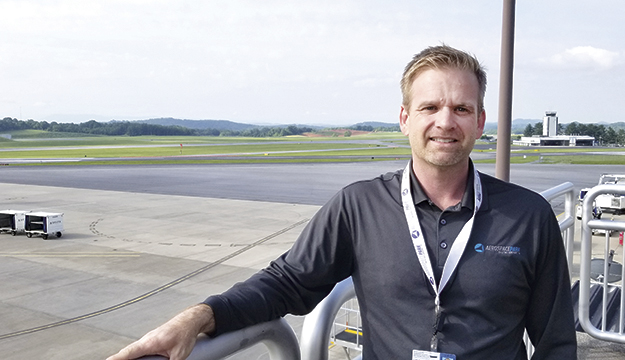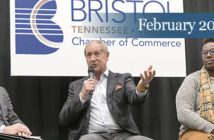Photo above: Mark Canty poses with Aerospace Park in the background. Photo by Scott Robertson
By Scott Robertson
The effort to bring the first tenants to the aerospace industry-targeted park on the south side of the main runway at Tri-Cities airport is a multi-faceted affair. After all, when one invests just shy of $20 million in creation of a park to attract high-paying jobs and capital investment, one doesn’t just take out a want ad.
The broadest effort the airport is making is to market Northeast Tennessee as a region where a viable aerospace cluster already exists (thus proving to potential tenants that an aerospace-industry-ready workforce also exists). Drilling down closer to the target, the airport is targeting specific companies. That effort includes partnerships with existing economic development organizations. Networks Sullivan Partnership is by far the most active, as the airport is located in Sullivan County. However, the Northeast Tennessee Regional Economic Partnership, the Tennessee Department of Economic and Community Development (TDEC) and the Tennessee Valley Authority (TVA) all play active roles. “We’re reminding our state and larger regional organizations that we have this product,” says Patrick Wilson, airport director. “That allows us to go with them together after some specific projects.”
Like it’s 1999
When the three cities and two counties in the Sullivan/Washington County corridor voted separately to back a bond issue to help fund the project last year, the few dissenting voices (there were two negative votes among all five governing bodies) worried that the project might have been underthought and overly speculative.
In truth, the project planning goes back to 1999, when the airport’s governing body, then known as the Tri-Cities Airport Commission, drew up a master facilities plan. “That plan identified what is now known as Aerospace Park as an area for ‘aviation-related industrial development,’” Wilson says. The airport has been making facilities improvements to make the park more accessible since. “The first phase of the taxiway on that side of the airport went in in 2001,” Wilson says.
That 17-year-old taxiway is key because it directly links Aerospace Park to the main runway. That connection is one of the greatest selling points the park has against competing aerospace development projects throughout the Southeast.
“Our focus is aerospace, but it is further narrowed down to aerospace companies that need runway access,” says Mark Canty, director of the Free Trade Zone and business development for the airport. “So, a parts manufacturer, we would probably not place them in Aerospace Park. We’re reserving that space for businesses that need to use the runway. One of the prospects we’re working with now needs 50-60 acres. So, it’s a big advantage to have a big contiguous site like ours, all with taxiway frontage.”
Like it’s 2018
Today, Aerospace Park includes 21 ready-to-occupy, certified acres in addition to the 140 acres being leveled. Canty has already been marketing that space, and he’s constantly ready to pitch the property. “Geographically it’s great, between the population centers of Miami and New York – the whole east coast, really. Tennessee is a right-to-work state, so that helps. The weather is a plus, the climate creates surprisingly few snow days here at the airport. Just being in the Southeast, where a lot of the automotive industry has moved is good, because a lot of the skillsets from automotive apply to aviation. A lot of good things come together to create a synergy here, and we have a good opportunity to take advantage of that.”
Canty’s enthusiasm is important, because the airport eschews mass marketing in favor of personal connections. “We made the decision early on to work on establishing relationships within the industry, targeting potential prospects,” Canty says. “So, we decided we would do a lot of trade shows, get out and meet those people face-to-face and try to spread the word about Aerospace Park.”
The airport and Networks have, for the last few years, split the cost of attending the MRO Americas show, the largest show dedicated to companies that do maintenance, repair and overhaul of aircraft. “MRO Americas draws MRO companies from around the world,” Canty says. “We typically will sponsor a booth and have an ad in the trade publication to highlight Aerospace Park. It’s our best opportunity to meet these companies on a one-on-one basis.”

TCA receives grant funding from the Tennessee Department of Economic and Community Development. Photo by Dave Ongie
“Networks is a tremendous partner,” Canty says. “They step up to the plate even when we don’t ask them to. They’ve sent three different people to MRO Americas. Also, Richard Blevins from Northeast State typically goes with us. We get a ton of questions about aviation maintenance education because there’s a national shortage of technicians. Richard speaks that language better than we do.”
Canty also attends the National Business Aviation Association’s annual meeting. “We typically don’t display there, just because it’s so huge. It may be the largest aviation conference in the world and airports don’t stand out as much there.” Attending that conference is more for industry intelligence than actual marketing, Canty says. “It’s a great place to hear industry announcements. It’s a great place to just walk the floor to find somebody new who may be interested.”
The airport has also begun displaying at another industry show, Cargo Facts. “It’s a conference dedicated to a growing sector, which is the passenger-to-freighter (P2F) industry. They take 737s, 747s and 777s out of passenger service, strip out the seats, put tracks in and turn it into a freighter.”
That show yielded a prospect who visited the airport, showing interest in both MRO and P2F conversion possibilities. “So clearly that’s a promising area for us as far as targeting prospects,” Canty says.
Other prospects have also expressed varying levels of interest, based on the marketing efforts to date, Canty says. “We’ve had conversations with a particular airline maintenance provider, for instance. They’re expanding and they’ve placed facilities throughout the country and they’re currently looking in the Southeast. There’s nothing imminent there, but we are on the cusp of having the activity there they would need to justify putting a facility here. We have a couple of other MRO providers, one in the state of Florida we regularly are in contact with.”
Other prospects have come from LinkedIn connections, Canty says. “Two of what I would consider to be the most solid prospects have actually visited Aerospace Park and have done regional tours. Each of those has asked us to visit them out of town, one at their headquarters and another at the home base of their US operations because they are a European company that has yet to establish a North American facility.”




